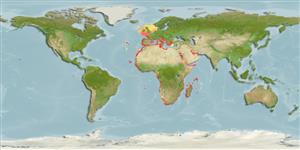Common names from other countries
Elasmobranquios (tiburones y rayas) (sharks and rays) >
Myliobatiformes (Stingrays) >
Myliobatidae (Eagle and manta rays)
Etymology: Myliobatis: Greek, mylo = mill + Greek, + Greek, batis,-idos = a ray (Raja sp.) (Ref. 45335).
More on author: Linnaeus.
Environment: milieu / climate zone / rango de profundidad / distribution range
Ecología
marino; salobre bentopelágico; rango de profundidad 1 - 300 m (Ref. 4440). Subtropical; 60°N - 36°S, 32°W - 58°E
Eastern Atlantic: Madeira, Morocco and the Canary Islands north to the western coasts of Ireland and British Isles and the southwestern North Sea, south to Natal, South Africa. Also throughout the Mediterranean.
Length at first maturity / Tamaño / Peso / Age
Madurez: Lm ?, range 60 - ? cm
Max length : 183 cm WD macho / no sexado; (Ref. 4440); peso máximo publicado: 14.5 kg (Ref. 40637)
Short description
Claves de identificación | Morfología | Morfometría
A plain eagleray with a short, rounded snout; disc with broadly angular corners, and upper or lower jaw usually with 7 rows of plate-like teeth (Ref. 5578). Brown or blackish dorsally, white ventrally (Ref. 5578). No caudal fin (Ref. 5578).
Body shape (shape guide): other.
Found in shallow lagoons (Ref. 3965), bays and estuaries; also offshore down to at least 95 m (Ref. 5578). Often found in groups (Ref. 5578). Feeds on benthic crustaceans, mollusks and fish. Ovoviviparous (Ref. 50449). Gestation period of 6-8 months, the females give birth to 3-7 young (Ref. 35388). Caught by shore and ski-boat anglers, usually released after capture (Ref. 5578). Flesh is highly esteemed (Ref. 3965).
Exhibit ovoviparity (aplacental viviparity), with embryos feeding initially on yolk, then receiving additional nourishment from the mother by indirect absorption of uterine fluid enriched with mucus, fat or protein through specialised structures (Ref. 50449).
McEachran, J.D. and B. Séret, 1990. Myliobatididae. p. 67-70. In J.C. Quero, J.C. Hureau, C. Karrer, A. Post and L. Saldanha (eds.) Check-list of the fishes of the eastern tropical Atlantic (CLOFETA). JNICT, Lisbon; SEI, Paris; and UNESCO, Paris. Vol. 1. (Ref. 4440)
IUCN Red List Status (Ref. 130435: Version 2025-1)
Threat to humans
Harmless
Human uses
Pesquerías: escaso valor comercial; pesca deportiva: si
Herramientas
Special reports
Download XML
Fuentes de Internet
Estimates based on models
Preferred temperature (Referencia
123201): 11.7 - 19.8, mean 15.2 °C (based on 318 cells).
Phylogenetic diversity index (Referencia
82804): PD
50 = 0.5002 [Uniqueness, from 0.5 = low to 2.0 = high].
Bayesian length-weight: a=0.00389 (0.00119 - 0.01269), b=3.08 (2.83 - 3.33), in cm total length, based on LWR estimates for this (Sub)family-body shape (Ref.
93245).
Nivel trófico (Referencia
69278): 3.6 ±0.54 se; based on food items.
Resiliencia (Referencia
120179): Muy bajo, población duplicada en un tiempo mínimo superior a 14 años (Fec=3).
Fishing Vulnerability (Ref.
59153): Very high vulnerability (83 of 100).
🛈
Climate Vulnerability (Ref.
125649): Moderate to high vulnerability (47 of 100).
🛈
Nutrients (Ref.
124155): Calcium = 6.54 [0.80, 118.48] mg/100g; Iron = 0.508 [0.046, 6.020] mg/100g; Protein = 20.4 [15.1, 25.6] %; Omega3 = 0.205 [0.068, 0.558] g/100g; Selenium = 36.1 [6.7, 193.9] μg/100g; VitaminA = 3.95 [0.36, 41.63] μg/100g; Zinc = 0.492 [0.030, 5.489] mg/100g (wet weight);
